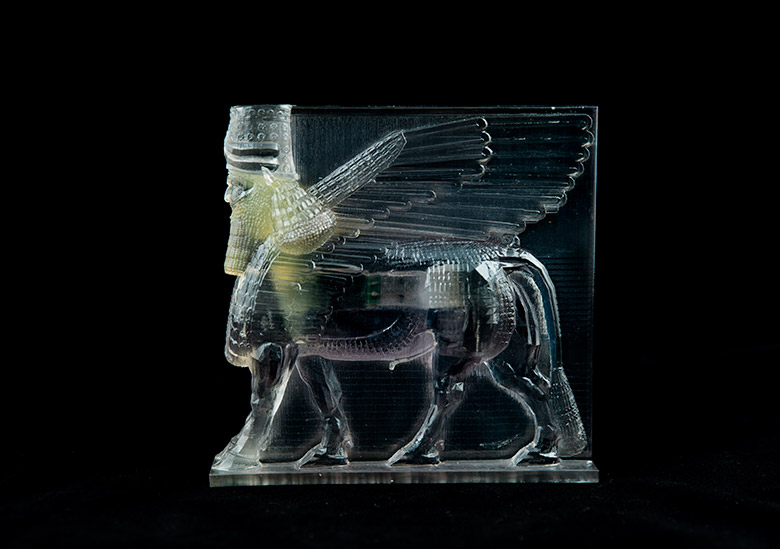
Morehshin Allahyari, Material Speculation: ISIS, Image courtesy of artist, 2016
“We don’t have time to lose,” Bokova told Reuters in 2014, “because extremists are trying to erase the identity, because they know that if there is no identity, there is no memory, there is no history.”
Alleviating such losses has since become a vital point of focus, and digital preservation has been at the forefront. In 2014, US Secretary of State John Kerry announced a partnership with the American Schools of Orient Research to “comprehensively document the condition of, and threats to, cultural heritage sites in Iraq and Syria to assess their future restoration, preservation, and protection needs”. The 2015 destruction of temples in Palmyra, Syria, led to a partnership between UNESCO and the Institute of Digital Archeology, which will utilize more than 5,000 3D cameras to capture scans of local ruins and relics.
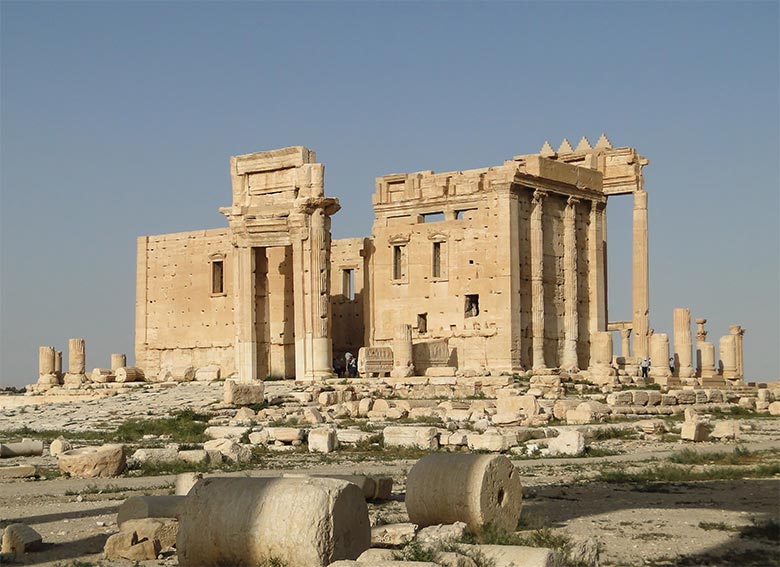
Cella of Temple of Bel in Palmyra, Syria, 2010. Destroyed in 2015. Photography by Bernard Gagnon.
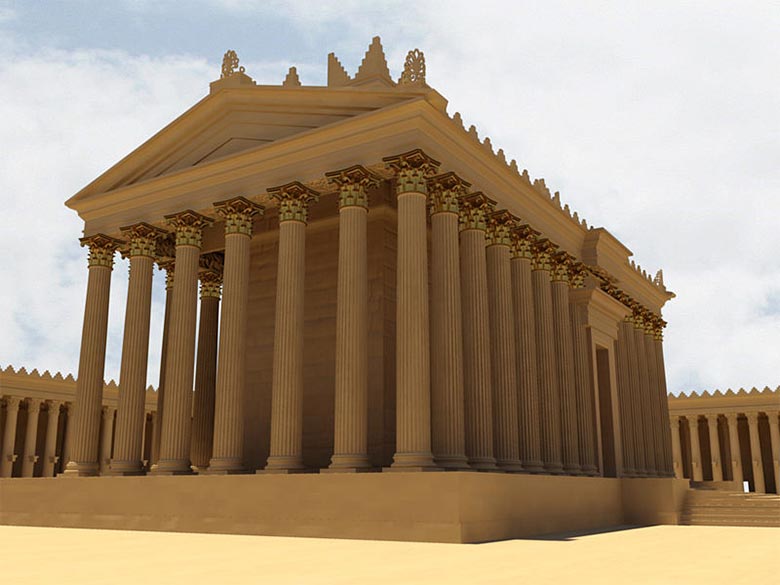
Digital reconstruction of the Temple of Bel from the #NEWPALMYRA Project.
Portland-based artist Ryan Woodring, likewise, has used 3D printing to recreate destroyed artifacts — but as an experienced visual effects artist, rewrites history with his Decimate Mesh series. Working with propaganda footage capturing artifact destruction at Iraq’s Mosul Museum, Woodring alternately removes ISIS members or the artifacts they are destroying, thus bringing a god-like power to the artifacts themselves or humorously trivializing their aggressor’s movements.
Included in this thoughtful discourse between Allahyari and Woodring, the two speak on a number of sociopolitical and cultural topics — as well as how to use modern mediums like 3D printing and video manipulation to navigate or comment on those complexities.
Text by Vivian Hua; Joint Interview by Morehshin Allahyari and Ryan Woodring
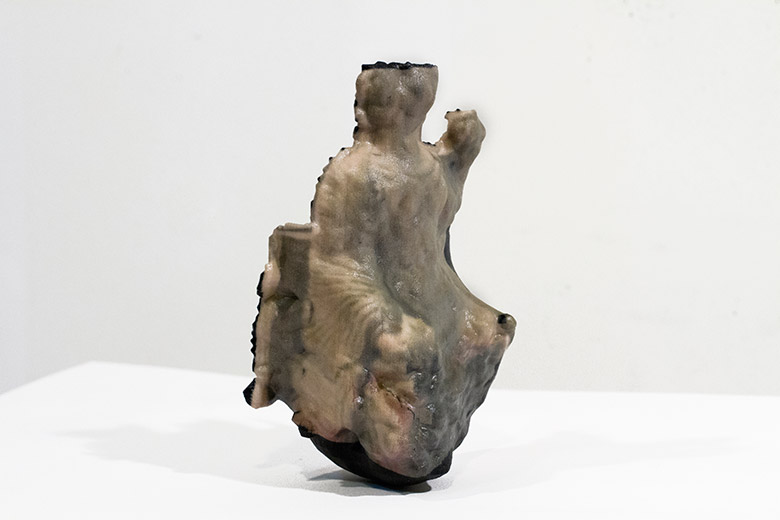
Ryan Woodring, Decimate Mesh, Image courtesy of the artist, 2015
Morehshin, you’ve deservedly had a great deal of press generated around your series Material Speculation: ISIS. You’ve talked about your 3D-printed replicas of destroyed Assyrian and Hatrene sculptures in the context of your art practice, and yet the project has also been written about so much as cultural preservation and in some cases, even co-opted as part of a larger fight against ISIS.
How has this project intentionally and/or unintentionally drawn you outside of aesthetic conversations into realms of cultural preservation, archaeology, history, etc.? What have been some of the more promising conversations that have come from this? Have any completely misunderstood your intentions?
As an artist and activist, this is one of the most important components of my practice: to make work that can go beyond aesthetic or the problems of the art world. So the fact that my Material Speculation piece project has had the potential of existing outside of that, is really one of the most exciting aspects of this project…
But also, working on a project like this comes with a lot of complications. Especially in a current political circumstances that we are in, in which Muslims are experiencing a lot of generalizations and Islamophobic attitudes toward them (due to events like refugee crisis, Paris attack, etc). So being an artist, born and raised in Iran, through the development of this project, I found it necessary to remind my audience, the press, etc., that ISIS does not mean Muslims. and that we should also talk about U.S. military’s destruction of sites in Afghanistan and Iraq in the last decade and that we should talk about the role of the U.S. military in the formation of ISIS in the first place. It’s easy to get lost in how horrible ISIS is by forgetting the cycle that ISIS is a part of. So in many ways, people in the West would just take this Us vs. Them approach which I found troubling. I often think that so much of the life I live is stuck in the middle of this kind of black and white perspectives.
I wonder if you have experienced any similar issues with your project, and if so how have you dealt with it?
My work has comparatively flown under the radar but pulls content from the same loaded subject matter, so I have engaged in many conversations on an artistic and political front. I think that the more troubling and flat conversations have come from misunderstandings of me as a patriotic visual effects artist on a mission to reclaim visual effects for America by removing ISIS members from their video of museum destruction. I am glad you identified the cyclical nature of war and terrorism, as the more difficult aspects of my research have lead me back to Hollywood’s polarizing representations of the Middle East, which contributes to a cycle of misunderstanding and violence.
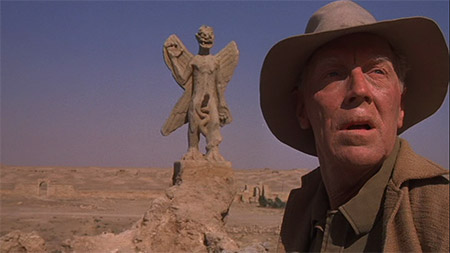
The Exorcist, 1973, Film Still of Pazuzu
Several articles about the destruction of Hatra noted, for example, that the ancient city had been the backdrop for the beginning of the 1973 American film The Exorcist, without explaining what purpose it served in that movie. In the film, Hatra is the site of a nonsensically outdated excavation in which an Assyrian deity named Pazuzu is unearthed. A Catholic priest immediately identifies [that] as a sign that the devil has been released — the same devil that ends up in a white American girl’s body in Washington DC.
God vs Devil is the ultimate polarization of the monotheistic religion of Catholicism, not the polytheistic religion which Pazuzu is culled from. Beyond my current project, I’d like to investigate and appropriate more polarizing American mass media exports.
I have been working on a couple of projects that attempt to use 3D printing in a critical way, including my Dark Matter series and The 3D Additivist Manifesto.
In general, thinking about 3D printers as poetic and practical tools for digital and physical archiving and documenting has been a concept that I’ve been interested in for the last 3 years. In my Dark Matter series, I approached this more from a political and cultural standpoint with focus on objects/things that are forbidden/unwelcome in Iran.
Last year, I was in the middle of a series of research, trying to connect all these conceptual points around plastic, 3D printing, oil, Technocapitalism, and Jihad when the video of ISIS destroying artifacts at Mosul Museum and other sites in Iraq went viral. Watching those videos came with so many layers of conceptual and personal relationships. At that point, I had also done different projects using 3D printing as a political tool/tool for resistance. So it made sense for me to think about a project in response to the destruction as a continuation of my research and wanting to push the radical possibility of a 3D printer as a tool for social and political resistance and movement.
Being that the majority of objects in the Mosul Museum when terrorists vandalized the site had already been removed and replaced with replicas, did you approach your reproductions differently based on whether the sculpture you were modeling was an original or a replica? Male or female?
Yes! When the video of ISIS destroying the artifacts in Mosul Museum came out, there were a lot of discussion around which were original and which were copies. So I got in touch with a lot of archeologists, historians, and scholars in Iran, Iraq, and the U.S. and Europe to gather reliable information about the artifacts that were original, their history, their name, etc. After months of research, and then later working with some of the former staff of Mosul Museum I chose 12 artifacts to work on — all which were destroyed and were original. Then in the middle of my research, I became interested in learning more about the female artifacts. Because of the lack of their presentation (only 13 lifesize statues of mortal women known from Hatra compared to some 120 statutes of men. This reflects the women’s lower social status in Hatrene society)…
Also there are all these concepts around the destruction of female artists/body and their relationship to jihad and Islam that I’m interested in.
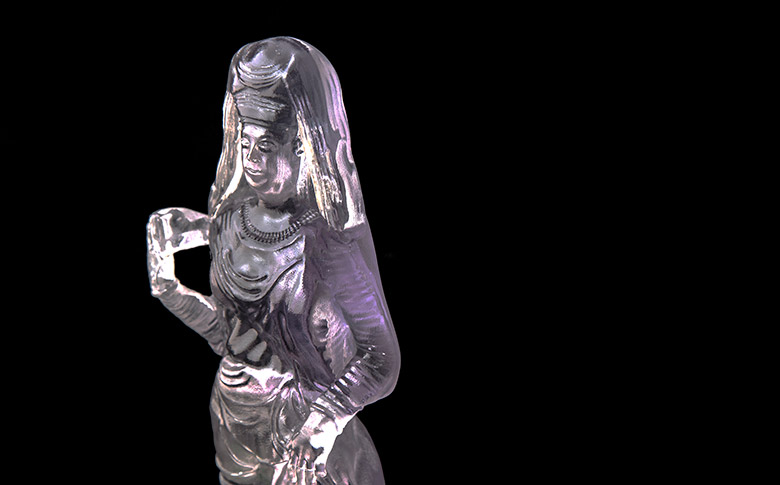
Morehshin Allahyari, Material Speculation: ISIS, Image courtesy of artist, 2016
Someone recently told me how the transparent resin material that I have chosen for my artifacts have this very ghostly visual aesthetic to them, and I found that also conceptually beautiful and important: the fact that I am only creating a ghost of these objects, rather than replacing them.
I think your videos and the visual effects you have chosen have the same element to them… The removal of men from ISIS and replacing them by these ghosts that remove the covers from the artifacts or destroy them or knock them down, etc.
Do you see a ghostly connection between our projects?
I love that your resin prints don’t try to mimic the plaster or stone from the originals. It makes sense that a ghost would take form in the most readily available materials of the time. I actually never considered that there could be another agent involved in those videos. I had thought of those as fragile performances of selfreflexivity on the part of the sculptures. But yes, now that you mention it, who could that invisible actor be?
I also wanted to mention that, as odd this sounds, I see those videos as additive rather than subtractive. One of the more interesting parts of removing something from a video is that it requires pixels from the rest of the video to fill in the gaps of what has been removed. A foreground object or actor is actively blocking information that sits behind it, and so when that element is “removed” it is actually just covered by an imagination of what the background should look like. Sometimes that is best achieved by cloning from other frames, sometimes by tracking the camera movement and projecting new images onto the scene. With the tarp scenes, there was a lot of actual digital painting and guessing what the motion of the tarp should look like.
Ryan Woodring, Decimate Mesh, courtesy of the artist, 2015
Can you tell me more about your decision to implant an SD card containing your research and software files in each reproduction?
I’m fascinated by the idea that you’re embedding a physical casing for digital information that, like any piece of hardware, will be outdated in a matter of years. I imagine your sculptures being opened 2,000 years from now and having some of the same issues of translation that you had in your research with museum texts (backward scans, incomplete translations, grainy image quality, etc.). This is perhaps a romantic idea since I know you’ve also put all of your research online but… I’d love to also hear your thoughts on objecthood in an increasingly digital world.
Because of the importance of the research and the gathering of information in the case of the lack of information… I found the sharing of this information as vital as the reconstruction of the artifacts themselves. Yes, inside each artifact there is a USB drive and memory card, onto which I have loaded images, maps, videos, PDF files, the process of creating the artifacts, and my email correspondence with historians and scholars. Since all this information will also be available online, one can think about these flash drives and the 3D printed artifacts as timecapsules and more of a metaphoric gesture.
For me, the objecthood of this project is important because it is rooted in the poetic idea of using an additive tool/process as a practical but also symbolic tool to add/rebuild the destroyed… the very process of an object being 3D printed and its relationship with this concept of “Desertification” that Reza Negarastani talks about in his Cyclonopedia: Complicity with Anonymous Materials book. He comes to it from the perspective of jihadists and terrorists and war on terror and how for jihadists, war and destruction is about this idea of flattening the earth, [with] “Desertification” as a way to restart something — as a way to take everything back to the beginning of Islam (that’s where the history starts). So I love that Additive process in 3D printing can be a metaphor against this idea of Desertification.
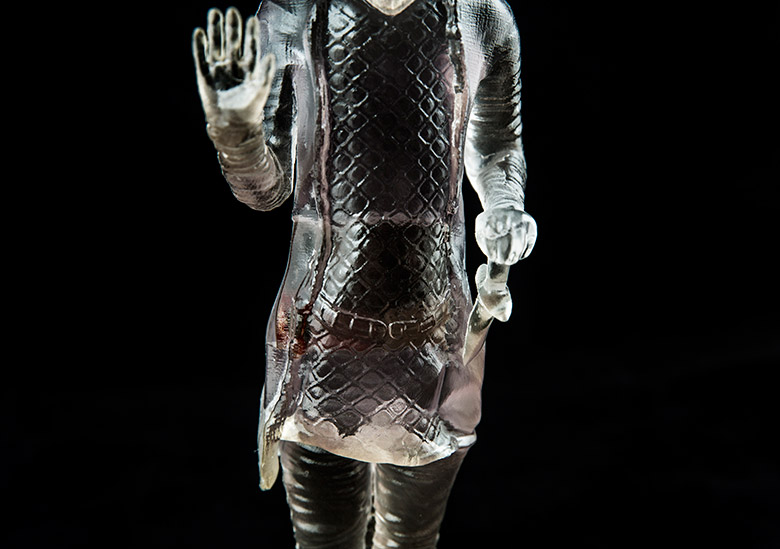
Morehshin Allahyari, Material Speculation: ISIS, Image courtesy of artist, 2016
I’m interested to know about your thoughts on the use of video as a medium for propaganda, especially because I find your focus on the video — instead of the objects themselves or the reconstruction of the artifacts - really refreshing.
Why did you become interested in the video of the destruction of the artifacts at Mosul Museum in first place? I think it’s insane that we live in a time that a group like ISIS uses Youtube and Social Media and “going viral” as tools for promoting their beliefs. What are your thoughts on that?
Images of destruction are a fascinating form of propaganda for an “iconoclastic” regime, because in order to convey the value of the objects on the precipice of destruction, the cameramen and editors chose rather long sequences in which they were introducing us to the sculptures by either removing tarps from them or by panning around them. ISIS has made significant income from looting museums and selling similar sculptures on the black market — so destroying these objects rather than selling them was very much a visual move.
As an American with a nearly empty passport and a limited background in Assyrian and Hatrene art, I, along with a majority of internet users, was introduced to these sculptures on a computer screen in the context of their imminent destruction.
I want to also hear about your ideas on objecthood in your project. Your approach comes from a very different perspective where you remove the objects from the videos. So the gesture becomes the focus while there is an absence (the absence/removal of the object)… I want to hear about that relationship. And the fact that the way ISIS has decided to use certain kind of gesture/s (gesture: a movement of part of the body, especially a hand or the head, to express an idea or meaning.) as act of destruction and violence.
I originally chose photogrammetric rebuilding of the sculptures as a way to physicalize that moment in which a sculpture that had long been hidden from a majority of the world was given a chance to introduce itself, if only for it to make its case for existence before being destroyed.
The longer an object was filmed, the more information the computer had to try to stitch it back into a 3D object. This was never a practice in accuracy, and as these explorations continued, I started to feed the photogrammetry software too many frames, asking it to rebuild entire scenes from the video. It was at this time that I came across your work and was enamored and impressed with the lengths of intimate research and translation and modeling you were going through in order to restore the forms and expand the conversation around these destroyed objects. Personally, I wanted to thank you for all of your incredible art and activism.
At that time, I was also working as a visual effects artist at a stopmotion animation company called Laika where I was tasked with digitally removing unwanted elements from videos things like metal rigs, shadows, strings, seams, etc. A coworker at the time sent me an article about ISIS’s use of visual effects in some of their videos. I think there’s a great fear that a terrorist organization could be as good at media manipulation and circulation as a country who, as you said, helped give rise not only to cinema but to that terrorist entity. I began using my skillset as a digital object remover to directly appropriate ISIS’s video and remove the men in the scenes, leaving only sculptures that appear to be unveiling themselves in violent repetition (2 to 5 second clips). These are doomed moments of reveal, of synchronized fame and annihilation.
But I’m also interested in gif and more largely digital memory as eternal life support for physically nonexistent things. And this is all further complicated by knowing that many of the destroyed sculptures were replicas whose doubles exist in near and distant museums. That knowledge compelled me to try this current iteration of work, in which I remove, instead, the sculptures, from the video, leaving only angry gestures from angry, mortal men, exerting their scarce energy at the air. I do think at the base of it I am also interested in not allowing the sculptures and their destroyers to be in the same video, or in the same room, or on the same server as one another. That to me at least weakens the propaganda.
Ryan Woodring – Decimate Mesh (2015)
How do you think the removal of the artifacts from your video changes our experience of destruction? The fact that we don’t see things falling off and shattering and being broken… How does that change our relationship to destruction and violence?
I’ll quickly say that I’m also interested in conversations about the digital afterlife of destroyed objects, and one of the most exciting collaborations I’ve had is with neuroscientist and computer programmer Brian Isett, who I’ve worked with to train a neural network to identify the form of a Lamassu (at least one of which was destroyed by ISIS in the video), as well as use the hundreds of thousands of images it was trained on (other images of Lamassu) to patch and “heal” the video of it being destroyed. Though our results have been far from utilitarian, it’s been a poetic exploration for us into the remembrance of forms even amidst a confusion of context. The Lamassu is a protective deity strategically placed at the gates of cities, so we were interested in symbolically doing its digital bidding by programming a regenerative piece of software based on past forms.
As far as the work I’m doing now to digitally remove the sculptures from this one video, I do think I’m influenced by what Susan Sontag wrote about Western photojournalists historically portraying and even exaggerating scenes of carnage in non-Western countries, while shying from these graphic depictions at home. Though I’m fascinated by the paradoxical way in which ISIS’s video serves as both a piece of propaganda and an educational tool, I think there’s something to be said for evacuating the sculptures from the site of their demise especially considering the complicated circumstances in which many of them became replicas in the first place.
In your Decimate Mesh videos, repetition is an important component. In my project, repetition comes in a different form, by releasing the .obj/.stl files of my artifacts to public and letting the digital files being saved and copied and 3D printed by anyone who has access to a 3D printer. So for me, repetition and copying creates power and collective resistance.
Can you tell me a bit about that relationship for you?
By the time ISIS had removed the Mosul Museum video (a day after its release) it had already been copied thousands of times and released by all major news outlets as visual evidence for a story that they had already leaked days in advance. For a supposedly iconoclastic act, the videos replicate the images of the destroyed sculptures (in most cases showing before and after) in a uniquely digital way. Because of the difficulty of separating these staged acts of object destruction from ISIS’s larger body of atrocities against the human body, the consumable and shareable quality of aggression against nonhuman actors plays into its hands as a propaganda piece.
With this type of destruction-based propaganda conveyed by digital imagery, I think it’s important not only to address the replication/restoration of the actual sculptures, but also to tweak the conversations surrounding the video itself. I think this comes from the same type of repetition (social media clicks, eyes viewing articles, etc.) that allowed the propaganda piece to flourish in the first place spreading these ideas online and encouraging discussion.
As far as the repetition of the acts themselves, I wanted to remove the act of editing/splicing/collage from the original video and instead treat each clip like the sculpture that was being filmed in it. I displayed each looping video on a pedestal to further suggest the singularity of each cut of video. Now that I’ve moved on to removing the sculptures and leaving only the repeating gestures of the perpetrators, I think I’m most interested in showing the banality of the anger exerted by mortal beings in the face of works of art that will, destroyed or preserved, be remembered long beyond these acts of staged aggression.
Ω
Woodring has shown extensively in solo and group exhibitions in the Pacific NW and Pittsburgh, and has murals on display in Carnegie Mellon’s Qatar Room and the University of Pittsburgh’s Turkish Room in the Cathedral of Learning. His latest video installation will be on view at the Portland Biennial in July, 2016. Woodring, originally from Doylestown, PA, holds a BFA in Fine Arts (Electronic and Time Based) and a BA in French and Francophone Studies from Carnegie Mellon (2010) where he was awarded a Fifth Year Scholarship.
Morehshin has been part of numerous exhibitions, festivals, and workshops around the world. She has been an artist in residence at CMU STUDIO for Creative Inquiry (2015), Autodesk Pier9 Workshop in San Francisco (2015), and BANFF Centre (2013), among others.
Her work has been featured in NYTimes, Huffington Post, Wired, NPR, VICE, Parkett Art Magazine, Rhizome, Hyperallergic, Dazed Digital, Neural Magazine, Global Voices Online, and Al Jazeera among others. Morehshin is the CoFounder of the Experimental Research Lab at Pier9/Autodesk.

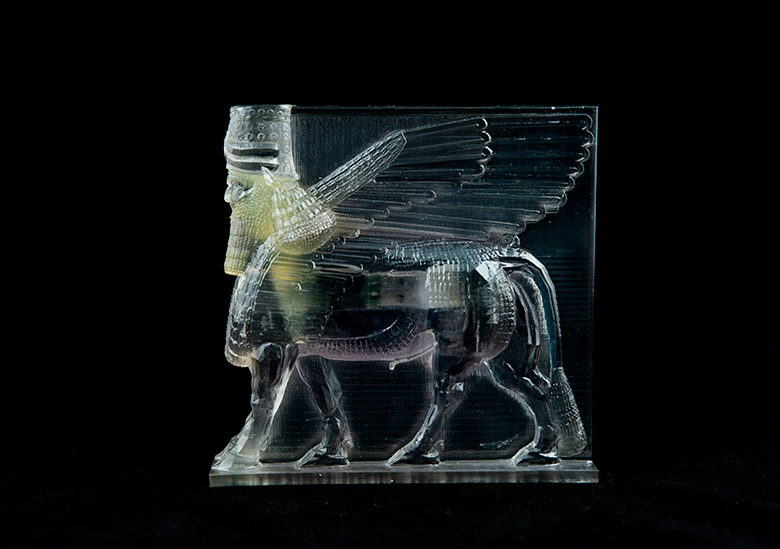





[…] link […]